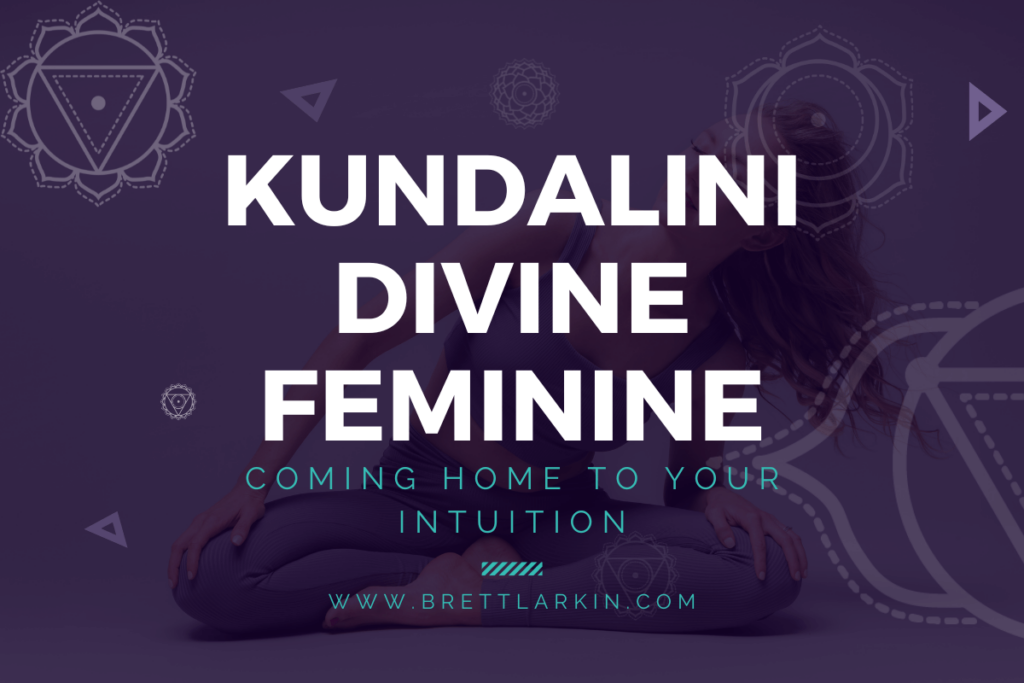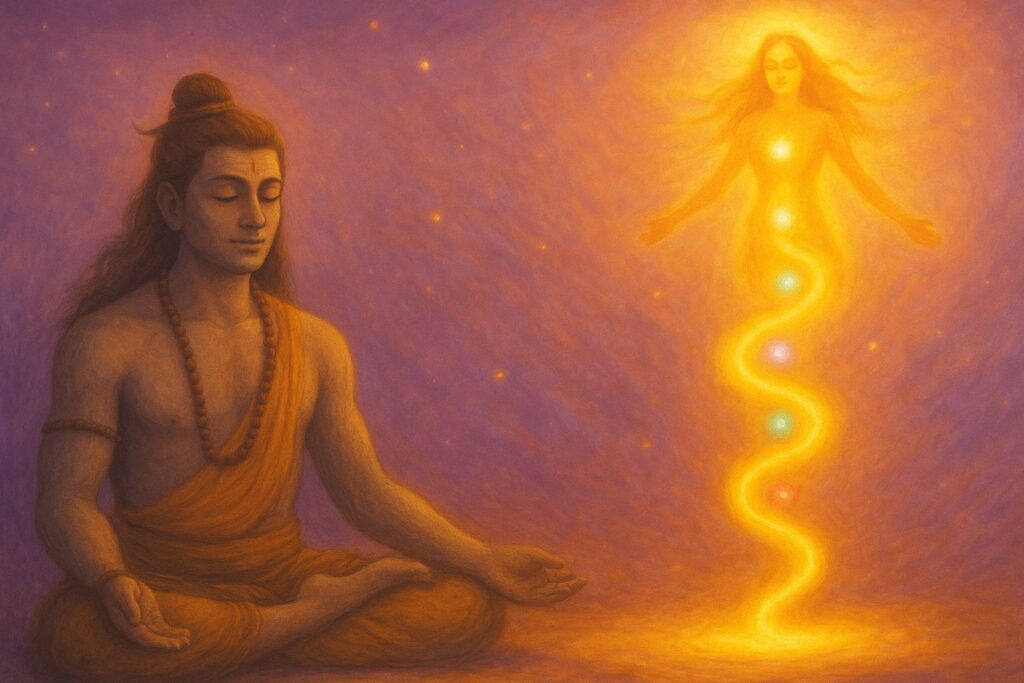Do you ever get sick of Kundalini’s rigid rules? The dogma? The structure? Are there ever days—especially as women during your period or the first few days of your cycle—when you just want to honor your body and how you want to move? So much of the Kundalini lineage is about pushing energy up the spine toward the crown through force, fire, and effort. Engage your root lock. Hold the pose. Keep your arms up. Meditate through the discomfort.
But what if it didn’t have to be so hard?
What if it could be easy?
What if instead of muscling your way to transcendence, you could rise through pleasure, not pressure?
I didn’t ask those questions until I got pregnant. That’s when the lightbulb moment hit. I realized I could still honor the wisdom of Kundalini yoga and deeply honor my feminine body—its softness, cycles, sensuality, and shifting needs. I started adapting kriyas to work for me, for how I was feeling in the moment. And what began as gentle modifications for pregnancy evolved into the Feminine Form Kundalini style I now teach and share with students of all genders today.
Because you don’t need to earn your bliss. You just need to remember how to feel it.
I want to show you how to awaken Kundalini energy through embodiment, not endurance. How to rise like the kundalini serpent—not in a straight line, but in a spiral. And how this sacred practice becomes even more powerful when you make it pleasurable.
Kundalini Divine Feminine is about more than modifying a practice. It’s about reimagining it. This isn’t just a style of yoga—it’s a spiritual path of coming home to your intuition, sensuality, and emotional truth. It’s kundalini awakening through movement that feels good, expressive, and free.
This post will show you how you can make kundalini rise through pleasure, not pressure. How you can awaken divine energy, not by force, but by spiral. And how kundalini yoga, when practiced with feminine energy at its core, becomes one of the most nourishing and powerful tools on your spiritual path.
Kundalini and the Divine Feminine
Kundalini, a Sanskrit term meaning “coiled snake,” refers to a powerful form of spiritual energy believed to reside at the base of the spine. Traditionally, kundalini yoga aims to awaken this energy through chanting, repetitive movements, breathwork, and meditation to elevate consciousness through the chakras.
The divine feminine, on the other hand, represents the receptive, intuitive, and nurturing aspect of our inner world. While kundalini yoga is inherently designed to activate both polarities (masculine and feminine), many lineages have become overly structured and masculine in delivery. Feminine Form Kundalini reintroduces fluidity, sensuality, and grace into the practice—inviting students to move with the wisdom of their own bodies.
In my Uplifted trainings, we explore how to awaken kundalini shakti through pleasure, expression, and embodiment. This isn’t about abandoning structure; it’s about softening into it. Instead of the masculine energy of “poking and provoking,” we use divine feminine energy to play and seduce.
The Shiva/Shakti Creation Myth
At the heart of the kundalini serpent story is one of the most beloved tales in yogic cosmology—the Shiva/Shakti creation myth.
In yogic philosophy, the story of Kundalini energy begins with the divine dance between Shiva and Shakti—two cosmic forces representing masculine and feminine energies.
Shiva is pure consciousness, stillness, the unchanging observer. Shakti is dynamic energy, movement, the power of creation. In the myth, Shakti longs to unite with Shiva—not by rushing or forcing her way up to meet him, but by spiraling, rising, and unfolding through the chakras in a sensual, devotional journey. This union represents the highest form of awakening: when spiritual energy (Shakti) meets spiritual awareness (Shiva) in the crown chakra.
Kundalini yoga, in its most sacred form, honors this myth—but Feminine Form Kundalini embodies it. Instead of operating within a structure designed by men, for men, and passed down through masculine lineages—where Shakti must rise to meet Shiva—this is an integrative approach.
In Feminine Form Kundalini, your body becomes the vessel where Shiva and Shakti meet. Not as a linear ascent, but as a love story unfolding within you. Like the Tantrika, you become the sacred space where polarities play, merge, and create something entirely new.
It’s not about going up and out. It’s about allowing a divine dance to express itself through you.
This myth reminds us: you already carry both energies inside you. The divine feminine is the creative energy that births, builds, destroys, and renews. Shakti is life force, creative power, and kundalini serpent energy itself. When she spirals upward to unite with Shiva, it’s not just an energetic journey—it’s the dance of creation inside your very spine. The practice is not about becoming something else. It’s about remembering who you truly are—a living, breathing expression of the sacred feminine energy, dancing her way back to wholeness.
“Shakti isn’t just energy. She’s your creative power in motion.”
Characteristics of the Divine Feminine
So what does it really mean to embody the divine feminine? This isn’t about being soft for the sake of being soft—it’s about reconnecting to your body’s inner rhythms, trusting your emotions, and honoring your cycles. It’s the energy that reminds us we are whole even when we’re still, wise even when we’re messy, and powerful when we lead with grace.
The divine feminine energy is:
- Receptive and intuitive (think: trusting your gut, moving with emotion)
- Cyclical and creative (honoring the phases of your body and spirit)
- Expressive and emotional (sound, touch, and movement become medicine)
- Grounded in the body (embodiment over transcendence)
- Nourishing and compassionate (self-touch, slow movement, and rest)
To explore more, check out these related posts:
The Role of Feminine Energy in Kundalini Awakening
Awakening kundalini through the feminine form doesn’t mean we’re moving energy downward or avoiding ascension. Instead, we’re choosing a different texture of energy—one rooted in the sacral chakra, pleasure, joy, touch, and receptivity. We trade force for invitation. Rather than commanding kundalini energy to rise, we seduce it upward like a lover being drawn in.
Kundalini Awakening vs. Embodiment: What’s the Difference?
In traditional teachings, kundalini awakening is often described as a powerful surge of energy that travels up the spine, igniting spiritual vision, bliss, and even altered states of consciousness. But here’s the thing—awakening doesn’t always have to look like fireworks. It can be a quiet, grounded returning to the body.
Embodiment is about feeling deeply present in your skin, your senses, your breath. It’s how we make kundalini awakening livable, sustainable, and safe. Feminine Form Kundalini embraces this by rooting you in the body as the temple, not a vessel to escape from. Instead of chasing light at the crown, we invite light into the hips, the heart, the hands.
So often in modern yoga, we’re taught to transcend—to rise, ascend, leave the body. Feminine embodiment flips this. It says: go in, not out. Feel more, not less. Let the kundalini serpent rise because she’s loved and welcomed—not forced.
Feminine Form Kundalini integrates spirals, undulations, devotional sound, and intuitive flow. It opens space for emotional release and personal truth, aligning with the wisdom of Shakti energy, the divine force of the sacred feminine.
Kundalini shakti doesn’t just travel a straight line up the spine from root chakra to crown. She coils, she dances, she unfurls. The awakening happens through presence, not performance. This is how kundalini yoga becomes a spiritual path that invites your whole being—body, breath, soul—into the awakening.
“Feminine energy doesn’t rush. She spirals.”
Download My Trending Kundalini Dance Party & Transform Your Energy in Under 10 Minutes 💃

Download My Trending Kundalini Dance Party - Transform Your Energy in Under 10 Minutes 💃

Benefits of Awakening the Divine Feminine
Reconnecting with the divine feminine through kundalini yoga can be incredibly empowering. Instead of pushing through, you learn to listen in. Here’s what starts to happen:
- You begin to trust yourself, your inner authority, and your body again.
- You learn to honor where you are—especially throughout your menstrual cycle.
- Your nervous system gets to exhale. You soothe rather than strive.
- You reclaim safety, softness, and sensuality in your own skin.
- You begin to prove to yourself that less can be more—and that you don’t have to work harder to earn a blissful feeling.
- You connect with Kundalini Shakti in a way that feels personal, intuitive, and pressure-free.
- You shift from an achievement mindset into a relationship with your body and energy.
Regular practice may also foster greater self-trust, feminine awakening, and compassion toward self and others. Studies in somatic healing and neuroscience suggest that body-based, rhythmic practices like kundalini yoga increase interoceptive awareness, reduce anxiety, and promote parasympathetic activation—all of which support kundalini awakening and the alignment of chakra energies.
Take my feminine energy quiz to get a recommended practice for balancing YOUR feminine energy 👇
How to Practice Kundalini Yoga for Feminine Energy
In Feminine Form Kundalini, we use traditional kundalini yoga poses as a base—but layer in grace, sound, touch, and choice. Here’s how you can embody sacred feminine energy in familiar movements:
Here’s an example:
Spinal Flex (Seated & on Heels)
- Slow it down to a pace that feels natural and nurturing.
- Add a sense of undulation to the spine and breath.
- Stroke the thighs gently as you move forward and back.
- Swap Breath of Fire for long, deep breathing to create a more grounded experience.
- Let your exhale carry sound—sighs, moans, hums—to release emotion.
- Use the movement as a tool for emotional and energetic release.
Life Nerve Stretch Variations
- Trade up-down bouncing for wave-like, rocking movement.
- Add touch by massaging the extended leg or stroking the floor beside you.
- Let your chin lead as you rise to encourage gentle, heart-led movement.
- Stay longer in each shape if it feels good—pleasure over performance.
- Think of this as a dialogue with your body, not a pose to perfect.
Sufi Grind with Butterfly Hug
- Wrap your arms around yourself in a butterfly hug as you move.
- Spiral from the pelvis and let movement ripple up through the spine.
- Relax the jaw, close the eyes, and let your breath be audible.
- Use sound and sighs to deepen your connection to the moment.
- Let the shape become less of a technique and more of a self-hug.
Stretch Pose Substitutions (Bicycle + Leg Lifts)
- Replace rigid Stretch Pose with slow, mindful bicycle legs.
- Try one-leg lifts with deep, soothing breath if low back strain is present.
- Focus on awakening the navel without tension or gripping.
- Let your movement feel like an offering—not a punishment.
- Build energy with love, not stress or strain.
Ego Eradicator with Feminine Pause
- Keep the arm position of Ego Eradicator, but slow the rhythm.
- Substitute Sitali breath or long deep breathing for Breath of Fire.
- After the movement, pause in stillness and feel what’s shifted.
- Add a spiral, a soft sigh, or place a hand on your heart.
- Let the pause become the practice. That’s where Shakti speaks.
Healing with the Kundalini Serpent
In Feminine Form Kundalini, we honor the kundalini serpent not as something to master, but as something to meet. She’s the divine feminine energy coiled at the base of your spine, waiting to be awakened—not through force, but through love.
When she uncoils, she doesn’t shoot straight up like an arrow. She spirals, slowly and sensually, through the six chakras—pausing, unraveling, healing. As she ascends, she massages stuck emotions, clears energetic blocks, and restores wholeness to every layer of your being.
Your body is not just the container for kundalini shakti—it’s her partner in the dance. Through breath, sound, and sacred movement, you offer her a pathway that feels safe, pleasurable, and empowered.
You don’t have to wait for some big mystical moment. The serpent begins to rise each time you say yes to your body, yes to your desire, yes to your life.
“The kundalini serpent doesn’t strike—she rises through devotion.”
Closing Thoughts
Feminine Form Kundalini is an invitation to reclaim your body as your spiritual teacher. You still awaken Shakti, but you do it on your terms—with curves, softness, sound, and soul. You don’t have to keep up. You get to listen in. This is the sacred feminine energy at work: intuitive, wise, and wildly alive.
Want to delve deeper into this sacred path? Explore my Somatic Yoga Certification to experience how kundalini yoga, embodiment, and feminine energy weave together.
Take the Feminine Energy Quiz to learn more about your unique feminine strengths. Your body is wise. Your desire is sacred. Let it lead.
“Let your kundalini awakening be a dance, not a destination. Let it be your divine feminine homecoming.” – Brett Larkin
Next Steps
- Take a deep dive into embodiment and somatic yoga with my Somatic Yoga certification program.
- If you’re interested in practical kriya yoga as a way to improve your daily life and relationships, check out my Yoga for Self Mastery course.

FREE Embodied Yoga Workshop (usually $67) Somatic Techniques & Cord Cutting Ritual

YOU MIGHT ALSO LIKE
- Harnessing the Power of Kundalini Divine Feminine for Transformation
- Kundalini for Feminine Energy: Ignite Your Creative Power and Passion
- The Best Somatic Exercises for Anger Management and Emotional Release
- Understanding What is Divine Love: Key Insights and Perspectives
- 10 Inspiring Examples of Feminine Energy to Enhance Your Life
- The Perfect Yoga Practice For Your Menstrual Cycle Energy Levels
- Yoga to Connect with Feminine Energy: 5 Transformative Practices
- The Muse Archetype: Characteristics & Challenges
- Wise Woman Archetype: Characteristics & Challenges
- The Enchantress Archetype: Characteristics & Challenges
- Leaning Into Soft Feminine Energy: Finding Balance in a Busy World
- The Healer Archetype: Characteristics & Challenges
- The Mother Archetype: Characteristics & Challenges
- The Wild Woman Archetype: Characteristics & Challenges
- The Lover Archetype: Characteristics & Challenges














